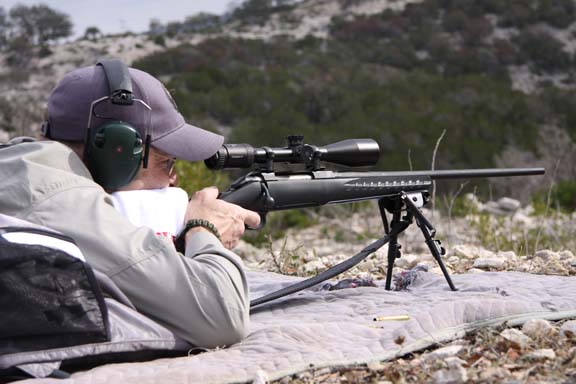
A serious workout with the Ruger American showed it to be a very capable rifle—one that retails for less than $500!
If there’s been a silver lining in these tough economic times, it’s the attention gun makers have paid to building guns that nearly anyone can afford. Certainly this is not a new phenomenon. Since the early days of the 20th century gun companies have developed low-cost models to round out their product lines.
Now, venerable U.S. gun company Ruger has jumped into the pool with the new American Rifle, a 100 percent made-in-the-USA centerfire bolt action. List price of the American is $449, which means you’ll probably be able to find it for $100 less at many outlets.
So what’s the big deal? If a company coming out with a low-end rifle model is nothing new, why is the Ruger American noteworthy? The difference is that, thanks to computer-aided design and cutting-edge production processes, economy guns are so much better now than they ever were—with great accuracy, good triggers and more features.

The American has a decent adjustable trigger, and in a departure for the company, the receiver is not milled for its base/ring setup. It’s drilled and tapped for Weaver bases, which are supplied.
And it is the trigger, among other features, that sets the American apart from, one, many other low-end rifles and, two, from the Savage AccuTrigger that set the bar for the modern sporting-rifle trigger. Like the AccuTrigger—to which the Ruger’s trigger was immediately compared when it was introduced—the Ruger Marksman Adjustable trigger employs a release lever in the shoe, but unlike similar designs, this release locks the trigger, not the sear, so no matter how low you set the spring, the sear cannot trip.
Adjustment is accomplished by screw in the front face of the trigger assembly. Adjustment range is a claimed three to five pounds; I was able to adjust the sample on mine to three pounds, three ounces, and as a test I turned the adjustment screw all the way out—and was able to verify Ruger’s claim that the sear won’t trip no matter how light the spring is adjusted.
The pull on the Marksman Adjustable is decent but not great because it’s got a little bit of creep in it, but the pull weights are consistent. Average pull weight as delivered was three pounds, 12 ounces for 10 pulls on a Lyman digital scale, and the weight never varied by more than two ounces.
I was more impressed with the design of the bolt, a one-piece, full-body affair that features a three-lug head. Ruger went this route because the full-body design requires less milling. The cool thing about the bolt is it features two cocking cams that divide the cocking force—requiring just six pounds of upward pressure to move the bolt handle through its 70 degrees of travel.

The synthetic stock features textured impressions on wrist and fore-end for a sure grip. The stock’s recoil pad does a great job of soaking up the kick of a 6.25-pound .30-06.
This design accomplishes a couple of things. One, the easy uplift means the bolt works easily so you don’t ever have to take the rifle off your shoulder to work the action (and you really shouldn’t, you know). Two, the 70-degree travel leaves plenty of room between the handle and whatever scope you decide to mount—unlike some bolt-action designs.
The full-body bolt glides smoothly in the receiver tube, making it a pleasure to cycle the action at whatever speed you desire. The bolt handle is one piece and fits in a squarish hole in the bolt body. The bolt shroud is relatively easy to remove for cleaning, but mind the owner’s manual caution not to move the cocking piece beyond what’s recommended or you’ll have a bit of a struggle to get it back into position. Guess how I know that?
Unlike Ruger’s flagship Model 77, the American Rifle features a sliding, two-position tang safety instead of the Winchester 70-type three-position wing. The action can be cycled with the rifle on Safe.
As mentioned, the receiver is enclosed, with flats machined into it for both looks and weight savings. And in a departure for Ruger, it does not feature the milling that permits the use of the company’s hallmark integral mount system. Instead, two single-slot Weaver bases (supplied, not installed) mate to matching holes in the receiver’s top.
One other feature deserves mention here. The bolt release is an unobtrusive spring-loaded lever at the left rear of the receiver—dispensing with the sharp (and ugly, in my opinion) release found on the Model 77.
Borrowing once again from the Savage playbook, the 22-inch, cold-hammer-forged barrel attaches to the receiver via a barrel nut. Unlike the Savage, though, the nut is smooth and hardly noticeable.

The full body bolt glides smoothly in the tube, and its twin cams permit easy bolt lift through its 70-degree travel. The bolt head is a three-lug design with a sliding extractor.
The Ruger American employs what it calls the Power Bedding system. It utilizes two bedding blocks that become part of the stock during the injection molding process; the glass-filled polypropylene flows around the blocks, locking them in place. These mate up with cutouts milled into the receiver tube, a setup that creates a solid platform for the barreled action and also negates the need for a separate recoil lug.


















